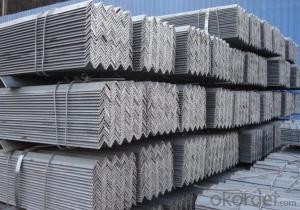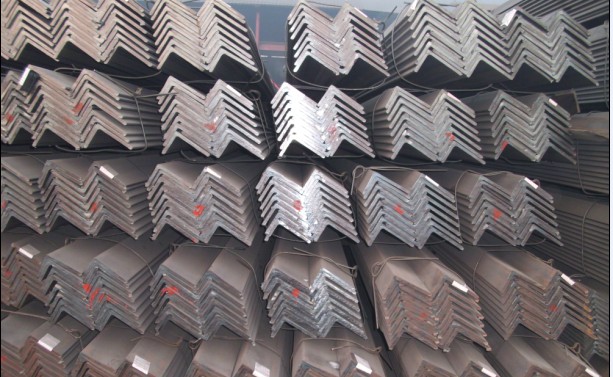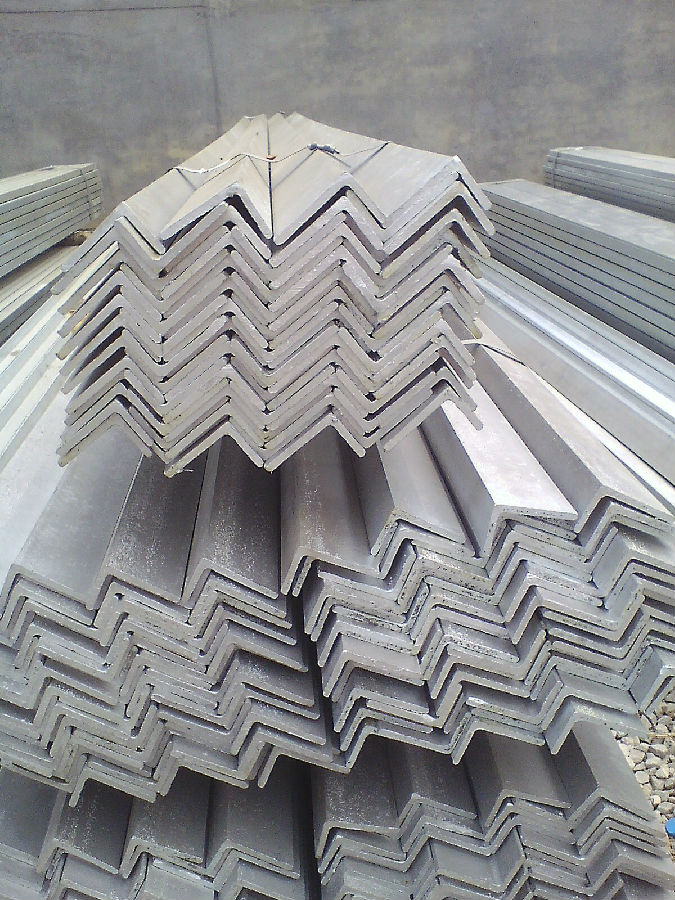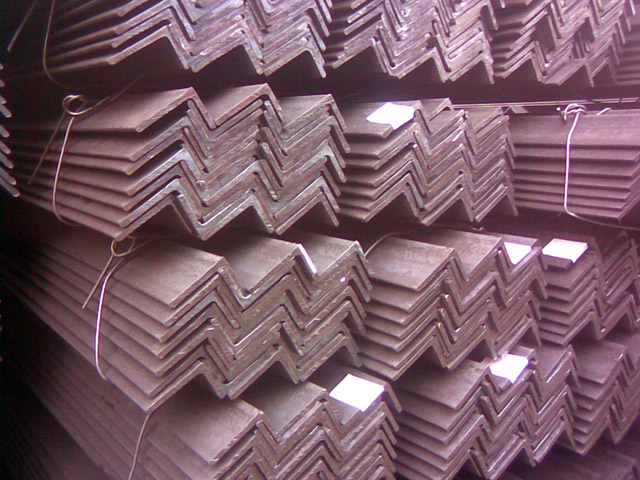High quality angle steel 20-250mm hot rolled GB Q235
- Loading Port:
- Qingdao
- Payment Terms:
- TT OR LC
- Min Order Qty:
- 25 m.t.
- Supply Capability:
- 100000000 m.t./month
OKorder Service Pledge
OKorder Financial Service
You Might Also Like
Product Description:Specificationsangle steel angle steel angle steel agle steel angle steel
Angle called angle, the steel strip is perpendicular to each other on both sides into angular.Divided into equilateral angle steel and ranging from side angle. Two equilateral angle steel edge width is the same. The specification is expressed by edge width * width * thick edgenumber of millimeters. Such as "/ 30 x 30 x 3", namely that equilateral angle steel edge widthof 30 mm, 3 mm thick edge. Can also be used to model representation, model is the wideangle 3# cm, such as. The model does not represent the same type in different edge thickness size, thus in the contract and other documents on the angle of the edge width, edgethick size fill in complete, avoid alone represented by type. Hot rolled equilateral angle steelspecifications for 2#-20#. Angle according to the different needs of structure composed of a variety of stress components, can also be used as a component of the connections between the. Widely used in a variety of architectural and engineering structures, such as beams,bridges, towers, hoisting and conveying machinery, ships, industrial furnace, reactor,container frame and warehouse. Mainly divided into equilateral angle steel, equilateral angle steel two categories, includingunequal angle can be divided into equal thickness and unequal thickness ranging from two. Angle specifications with the side length of the size and edge thickness. At present, the domestic steel specifications for 2 - 20 cm in length, number of numbers, the same horn steel often have 2 - 7 different edge thickness. The actual size and inlet angle marked on both sides of the thickness and indicate the relevant standards. The general length of more than 12.5cm for large angle steel, 12.5cm - 5cm for the medium angle, length of 5cm for smallangle. Inlet and outlet angle steel orders generally required the use specifications in the steel,carbon structural steel grades as appropriate. Is the angle in addition to standard number, nospecific composition and performance series. Angle steel delivery length is divided into fixed length, size two, domestic steel length range is3 - 9m, 4 12M, 4 19m, 6 19m four range according to different specifications. Japanese steellength ranges from 6 to 15m. Section of unequal angle height according to the long edge of the width to calculate the non equilateral angle steel. Refer to section angle and side length is not equal to the steel. Is a kind of angle steel. The length from 25mm * 16mm to 200mm * l25mm. By the hot rolling mill rolling in. General scalene angle steel specifications: thickness of 4-18mm / 50*32-- / 200*125 Equilateral angle steel is widely used in all kinds of metal structures, bridges, machinery manufacturing and shipbuilding industry, all kinds of architectural and engineering structures,such as beams, bridges, towers, hoisting and conveying machinery, ships, industrial furnace,reactor, container frame and warehouse etc. 1.Transportation: the goods are delivered by truck from mill to loading port, the maximum quantity can be loaded is around 40MTs by each truck. If the order quantity cannot reach the full truck loaded, the transportation cost per ton will be little higher than full load. 2.With bundles and load in 20 feet/40 feet container, or by bulk cargo, also we could do as customer's request. 3. Marks: Color mark: There will be color marking on both end of the bundle for the cargo delivered by bulk vessel. That makes it easily to distinguish at the destination port. Tag mark: There will be tag mark tied up on the bundles. The information usually including supplier logo and name, product name, made in China, shipping marks and other information request by the customer. If loading by container the marking is not needed, but we will prepare it as customer request. |
- Q:Can steel angles be used in modular construction or prefabricated structures?
- Yes, steel angles can be used in modular construction or prefabricated structures. Steel angles are commonly used as structural components in these types of construction due to their strength, versatility, and ability to be easily fabricated and assembled. They provide stability and support to the overall structure, making them a suitable choice for modular and prefabricated construction methods.
- Q:How are steel angles tested for quality and strength?
- Steel angles are tested for quality and strength through various methods, including visual inspection, measurement of dimensions, and mechanical testing. Visual inspection involves checking for any visible defects or imperfections such as cracks, surface irregularities, or rust. Measurement of dimensions ensures that the angles meet the specified size and shape requirements. Mechanical testing involves subjecting the angles to forces or loads to determine their strength, such as tensile testing to measure their resistance to pulling or bending, and hardness testing to assess their resistance to indentation. These tests help ensure that steel angles meet the desired quality and strength standards.
- Q:Can steel angles be used as supports for overhead doors or garage doors?
- Yes, steel angles can be used as supports for overhead doors or garage doors. Steel angles are commonly used in construction due to their strength and durability. They provide excellent support and stability for heavy doors, making them an ideal choice for overhead or garage doors. The angles can be securely attached to the walls or framework, providing a solid base for the doors to hang on and operate smoothly. Additionally, steel angles can be customized to fit the specific dimensions and weight requirements of the doors, ensuring proper support and functionality.
- Q:Can steel angles be used for playground equipment?
- Yes, steel angles can be used for playground equipment. Steel angles provide strength, durability, and stability, making them suitable for various playground structures such as swing sets, climbing frames, and slides.
- Q:How do steel angles compare to other structural shapes like beams and channels?
- Steel angles, beams, and channels are all structural shapes commonly used in construction and engineering projects. While each shape has its own unique characteristics and advantages, steel angles offer specific benefits that make them a popular choice. One key advantage of steel angles is their versatility. They can be used in a wide range of applications, including supporting heavy loads, bracing structures, and providing framework for various structures. Due to their L-shaped design, steel angles can easily be welded or bolted together to create larger structures or frameworks. Compared to steel beams, angles are typically more cost-effective. They require less material to manufacture, making them a more economical choice for projects with budget constraints. Additionally, steel angles are often lighter in weight compared to beams, which can be beneficial when considering transportation and installation costs. Steel channels, on the other hand, offer similar benefits to steel angles but have a different shape. Channels have a U-shaped design, which allows for increased stability and support. They are commonly used for applications where additional strength is required, such as in the construction of bridges, buildings, and machinery. While steel angles may not provide the same level of strength and load-bearing capacity as steel beams or channels, they are still a reliable choice for many structural applications. Their versatility, cost-effectiveness, and ease of installation make them a preferred option for a wide range of construction and engineering projects.
- Q:Can steel angles be used for signage or billboards?
- Yes, steel angles can be used for signage or billboards. Steel angles provide a sturdy and durable support structure for the signage or billboard, ensuring it remains stable and secure. Additionally, steel angles can be easily customized and fabricated to meet specific design requirements, making them a versatile choice for signage applications.
- Q:Can steel angles be used in sign support structures?
- Yes, steel angles can be used in sign support structures. Steel angles are commonly used in construction as they provide excellent strength and structural support. They can be easily welded or bolted together to form sturdy sign support structures that can withstand various weather conditions and loads.
- Q:Can steel angles be used in mezzanine flooring systems?
- Indeed, mezzanine flooring systems can incorporate steel angles. In the realm of mezzanine construction, steel angles are frequently employed as structural components due to their remarkable robustness and longevity. Whether utilized as supports, beams, or bracing elements, steel angles offer stability and an impressive load-bearing capacity to mezzanine flooring systems. Moreover, steel angles are adaptable and can be readily tailored and installed to meet precise design specifications. Additionally, they present a cost-effective and dependable solution for generating extra floor area in industrial and commercial edifices.
- Q:Are steel angles available in non-standard dimensions?
- Yes, steel angles are available in non-standard dimensions. While standard steel angles are typically produced in specific sizes, such as 2x2 inches or 3x3 inches, there are manufacturers and suppliers who can produce steel angles in custom sizes to meet specific project requirements. These non-standard dimensions could include different leg lengths, thicknesses, or overall dimensions that are not commonly found in standard steel angles. Custom steel angles can be fabricated through processes such as cutting, bending, and welding to achieve the desired dimensions. However, it is important to note that non-standard dimensions may require additional time and cost for production compared to readily available standard sizes.
- Q:What are the common uses for steel angles?
- Steel angles have a wide range of common uses in various industries and applications. One of the most common uses for steel angles is in construction and structural engineering. They are often used as framing elements in buildings, bridges, and other infrastructure projects. Steel angles provide stability, strength, and support, making them ideal for creating sturdy frameworks. In addition to construction, steel angles are commonly used in manufacturing and fabrication processes. They can be used as brackets, supports, and reinforcements in machinery and equipment. Steel angles are also used in the automotive industry for manufacturing vehicle frames, chassis, and various structural components. Another common use for steel angles is in the manufacturing of furniture and fixtures. They are often used as corner supports, shelf brackets, and frame reinforcements. Steel angles provide durability and stability, making them suitable for supporting heavy loads in furniture and fixtures. Steel angles also find applications in the electrical industry. They are used to mount electrical boxes, conduits, and other electrical components. The strength and stability of steel angles make them reliable for holding electrical equipment securely in place. Moreover, steel angles are utilized in the manufacturing of storage systems, such as shelving units and racks. They provide a strong and stable structure that can withstand the weight of stored items. Steel angles are also used in the construction of stairs, handrails, and guardrails, providing safety and support in various settings. Overall, the common uses for steel angles span across industries, including construction, manufacturing, furniture, electrical, and storage systems. Their versatility, strength, and stability make them a popular choice for various applications where structural support and durability are required.
1. Manufacturer Overview |
|
|---|---|
| Location | |
| Year Established | |
| Annual Output Value | |
| Main Markets | |
| Company Certifications | |
2. Manufacturer Certificates |
|
|---|---|
| a) Certification Name | |
| Range | |
| Reference | |
| Validity Period | |
3. Manufacturer Capability |
|
|---|---|
| a)Trade Capacity | |
| Nearest Port | |
| Export Percentage | |
| No.of Employees in Trade Department | |
| Language Spoken: | |
| b)Factory Information | |
| Factory Size: | |
| No. of Production Lines | |
| Contract Manufacturing | |
| Product Price Range | |
Send your message to us
High quality angle steel 20-250mm hot rolled GB Q235
- Loading Port:
- Qingdao
- Payment Terms:
- TT OR LC
- Min Order Qty:
- 25 m.t.
- Supply Capability:
- 100000000 m.t./month
OKorder Service Pledge
OKorder Financial Service
Similar products
New products
Hot products
Related keywords































